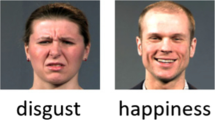Abstract
To examine children's ability to control their affective expression facially, 68 second- and fourth-grade boys and girls were unobtrusively videotaped while discussing six self-chosen activities about which they felt positively, neutrally, or negatively. Children then performed three facial management tasks: (a)inhibition (showing no emotion instead of a felt emotion); (b)simulation (showing an emotion when not feeling anything); and (c)masking (showing an emotion that is different than what is felt). Twelve raters judged the edited tapes of the children's performance for affect positivity and deceptiveness. Repeated measures ANOVAs indicated, in contrast to previous research, that children were highly competent in managing facial displays. To understand children's techniques for managing affective displays, two raters categorized the primary cognitive strategies children used. Results showed that fourth graders used more complex strategies more often than second graders. These results highlight children's skill and strategies in affect management.
Similar content being viewed by others
References
DePaulo, B. M. (1991). Nonverbal behavior and self-presentation: A developmental perspective. In R. S. Feldman & B. Rimé (Eds.),Fundamentals in nonverbal behavior (pp. 351–397). New York: Springer-Verlag.
DePaulo, B., & Jordon, A. (1982). Age changes in deceiving and detecting deceit. In R. Feldman (Ed.),Development of nonverbal behavior in children (pp. 151–180). New York: Springer-Verlag.
DePaulo, B. M., Stone, J. I., Lassiter, G. D. (1985). Deceiving and detecting deceit. In B. R. Schlenker (Ed.),The self and social life. (pp. 323–370). New York: McGraw-Hill.
Ekman, P., & Friesen, W. V. (1969). Nonverbal leakage and clues to deception.Psychiatry, 32, 88–106.
Feldman, R. S., Jenkins, L., & Popoola, O. (1979). Detection of deception in adults and children via facial expressions.Child Development, 50, 350–355.
Feldman, R. S. & White, J. (1980) Detecting deception in children.Journal of Communication, 30, 121–128.
Gnepp, J., & Hess, D. L. (1986). Children's understanding of display rules for expressive behavior.Developmental Psychology, 22, 103–108.
Halberstadt, A. G., Cassidy, J., Stifter, C. A., Parke, R. D., & Fox, N. A. (1993).Self-expressiveness within the family: Psychometric support for a new measure. Manuscript submitted for publication.
Harris, P. L., Donnelly, K., Guz, G., & Pitt-Watson, R. (1986). Children's understanding of the distinction between real and apparent emotion.Child Development, 57, 895–909.
Harris, P. L., & Gross, D. (1988). Children's understanding of real and apparent emotion. In J. W. Astington, P. L. Harris, & D. R. Olson (Eds.),Developing theories of mind. New York: Cambridge University Press.
Lewis, M., Stanger, C., & Sullivan, M. W. (1989). Deception in 3-year-olds.Developmental Psychology, 25, 439–443.
Lillard, A. S., & Flavell, J. H. (1992). Young children's understanding of different mental states.Developmental Psychology, 28, 626–634.
Morency, N., & Krauss, R. (1982). Children's nonverbal encoding and decoding of affect. In R. S. Feldman (Ed.),Development of nonverbal behavior in children (pp. 181–199). New York: Springer-Verlag.
Peskin, J. (1992). Ruse and representations: On children's ability to conceal information.Developmental Psychology, 28, 84–89.
Saarni, C. (1979). Children's understanding of display rules for expressive behavior.Developmental Psychology, 15, 424–429.
Saarni, C. (1988). Children's understanding of the interpersonal consequences of dissemblance of nonverbal emotional-expressive behavior.Journal of Nonverbal Behavior, 12, 275–294.
Shennum, W. A. (1981).The development of expressive control in nonverbal behavior. Unpublished doctoral dissertation, University of California, Santa Barbara.
Shennum, W. A., & Bugental, D. B. (1982). The development of control over affective expression in nonverbal behavior. In R. S. Feldman (Ed.),Development of nonverbal behavior in children (pp. 101–121). New York: Springer-Verlag.
Author information
Authors and Affiliations
Additional information
Funding for this project was provided by a NICHHD grant (#HD22367) to the first author. We gratefully acknowledge the assistance of Nancy A. Ballard and Michael G. Rakouskas in data collection and preparation. We also thank the children whose participation and cooperation made this research possible.
Rights and permissions
About this article
Cite this article
Halberstadt, A.G., Grotjohn, D.K., Johnson, C.A. et al. Children's abilities and strategies in managing the facial display of affect. J Nonverbal Behav 16, 215–230 (1992). https://doi.org/10.1007/BF01462003
Issue Date:
DOI: https://doi.org/10.1007/BF01462003




